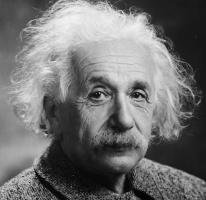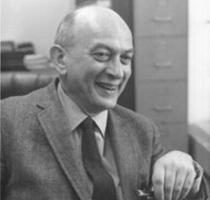Sewall Wright: biography of this American geneticist
There are authors whose work has meant a leap for the field of knowledge of him. This is the case of Sewall Wright and his studies on genetics.
We are going to review the most important events in the life of this researcher as well as describe some of his most relevant contributions to the science of genetics, through a biography of sewall wright in summary format.
- Related article: "What is the genetic code and how does it work?"
Brief biography of Sewall Wright
Sewall Green Wright was born in the city of Melrose, Massachusetts, United States, in the year 1889.. He was the son of Elizabeth and Phillip. It so happened that his parents were first cousins, an interesting fact that would have importance for the family. Sewall Wright's curiosity about inbreeding and its implications, as would later be reflected in some of his research.
Being very young Sewall, the family moved to Galesburg, in Illinois, since his father had obtained a position as a professor at the university institution of Lombard College. The atmosphere in the Wright house was very intellectual, which favored Sewall Wright's interest in very soon by sciences such as mathematics or biology, which would later be fundamental in his training. He first studied at Galesburg High School, until the year 1906, when he graduated.
Later he would enter Lombard College itself, the university where his father taught. He studied mathematics, but he was also lucky enough to receive classes from Wilhelmine Entemann Key, who was one of the first female doctors in the field of biology, a true pioneer. This author was key to the formation of Sewall Wright and his interest in the field of genetics.
In turn, Wright achieved his doctorate, no less than at Harvard University. It was precisely in this institution that he began his work as a researcher, working for the Bussey Institute. It was in this center where he had the opportunity to collaborate with William Ernest Castle, one of the first American geneticists, whose research focused on the study of mammalian fur tones and the factors that made them hereditary.
It was at this time that Sewall Wright also met Louise Lane Williams, whom he would marry in 1921. Three descendants would be born from this marriage, two males, Richard and Robert, and one female, Elizabeth. The happy couple would share a lifetime until Louise's death in 1975.
After his time at the Bussey Institute, Sewall Wright he began collaborating with the United States Department of Agriculture. In 1925 he moved to the University of Chicago to work as a researcher in the Department of Zoology. This would be his last destination, as he would spend no less than three decades and finally retire, already in 1955.
Sewall Wright ended his days in the city of Madison, Wisconsin, where he finally passed away in 1988, at the age of 98.
- You may be interested in: "Differences between DNA and RNA"
Studies in population genetics
Once we have taken a tour of Sewall Wright's biography, it is time to review his greatest contributions to the field of genetics, which were not few.
The first branch of genetics that Sewall Wright excelled in was population genetics.. Within this field he carried out investigations that had to do with inbreeding, in part, as we have already seen, moved in the case of his own parents, and how the fact of being first cousins could genetically affect his offspring.
In conjunction with these works, he also investigated both genetic drift and the mating systems of different species. Thanks to Sewall Wright and other authors such as John Burdon Sanderson Haldane or Sir Ronald Aylmer Fisher, population genetics experienced a major advance. In fact, Wright is considered the father of the neo-Darwinian synthesis, also called the modern synthesis of evolution.
Sewall Wright also discovered some of the keys to understand population genetics and to work with this concept in a mathematical way. One of them would be the coefficient of consanguinity, which gives us information about the probability that the parents of an individual have a common ancestor depending on the arrangement of the alleles of a specific gene.
The other tool created by Sewall Wright would be the F statistics or fixation indices, which tell us about the level of heterozygosity of a population, or what is the same, the disparity or genetic similarity between the individuals of that population in concrete.
Continuing contributions to population genetics, thanks to Sewall Wright the mathematical basis that explains the genetic drift of the species was established. In fact, this concept can also be found written as the Sewall Wright effect. The Genetic drift he explains the factors that cause successive generations of a given species to experience changes in the genetic sequence.
He also developed the concept of effective population size, that is, the minimum size of a fictitious population that we would need to be able to make inferences that adapt to the circumstances of the total number of individuals in the total population studied. To do this, a series of simplifications is used that statistically should not significantly alter the conclusions reached.
Studies of theory of evolution
Sewall Wright also studied in depth the relationship between the genotype / phenotype and the Biological fitness, which refers to the estimated offspring that a certain individual will have during their life. life. For it talks about evolutionary landscapes, hypothetical scenarios in which, depending on the height, the organism is more likely to reproduce.
According to genetic drift, the species will occupy the local peak and to reach a higher one it will have to go through a valley area where their odds will drop before rising again, this time with more force. This theory is valid for populations that are not too large. If they are older, they could be divided into smaller groups, some of which would manage to reach the highest peak.
If there were also genetic flow between both groups, the changes achieved by one of them could be shared with the rest, finally reaching the total population. This mechanism is another of Sewall Wright's approaches and It is known as the shifting equilibrium theory.. However, it is a controversial approach, since many evolutionists question whether the conditions usually exist for this to happen.
In fact, this issue led to a clash of positions with his colleague Sir Ronald Aylmer Fisher, since he argued that the populations would have to be smaller than what the majority are so that the theory proposed by Sewall Wright could fit, since the effects of genetic drift would be diluting as populations are so big.
Path analysis or route analysis is another of Sewall Wright's contributions. It consists of a statistical system, created in 1921 by this author and that since then has been used in a variety of scientific disciplines due to its great utility. Through a graphical model, the path analysis shows the researcher the causal relationships between different variables..
study with guinea pigs
Sewall Wright tried to investigate possible methods to somehow improve the characteristics of some species of animals and plants. For this he carried out an ambitious experiment with a population of 80,000 guinea pigs or guinea pigs. He established a group in which the mating would take place between sibling individuals, while in the other half of the population the mating would be random.
The results were the basis that allowed him to define the changing equilibrium theory, which we have already mentioned above. According to this concept, Sewall Wright affirmed that the adaptive evolution of a certain group of individuals could happen more easily if these groups were made smaller and thus the possibility of a flow was restricted genetic.
These studies were very successful among his students, which also raised new research to continue advancing in the field of genetics. One of those who most appreciated Sewall Wright's contributions was Jay Lush, who would eventually become a reference in quantitative genetic studies.
For all these works and many more, Sewall Wright Today he is considered one of the most important geneticists in history.a and received a whole series of awards that attest to his importance in this field of knowledge.
Bibliographic references:
- Provine, W.B. (1989). Sewall Wright and evolutionary biology. The University of Chicago Press.
- Wade, M.J. (1992). Sewall Wright: gene interaction and the shifting balance theory. Oxford surveys in evolutionary biology.
- Wright, S. (1931). Evolution in Mendelian populations. Genetics.
- Wright, S. (1932). The roles of mutation, inbreeding, crossbreeding, and selection in evolution. Proceedings of the Sixth International Congress on Genetics.
- Wright, S. (1949). The genetic structure of populations. Annals of eugenics. Wiley Online Library.



